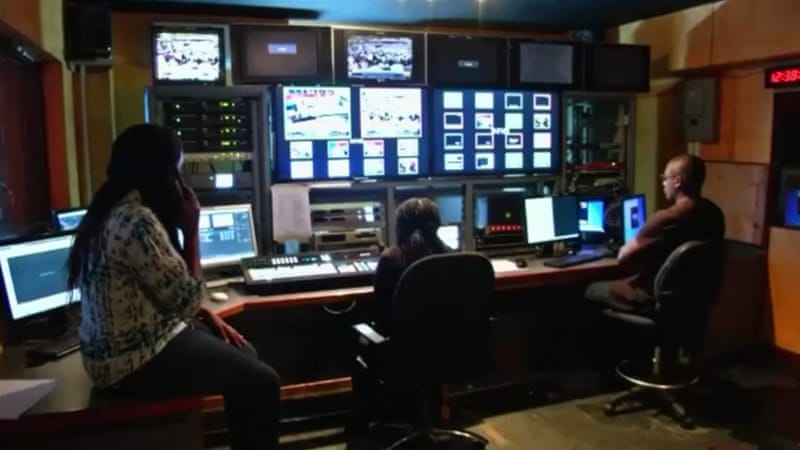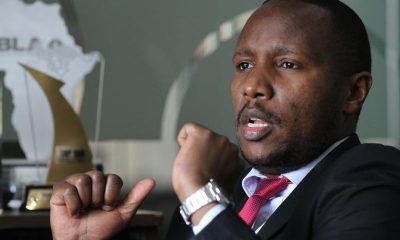Opinion
NYANCHWANI: Kenya’s Mainstream Media Is In Big Trouble

By Silas Nyanchwani
Undoubtedly, Kenya’s mainstream media organizations are in trouble. Big trouble. They have been since 2015.
Losses, profit warnings, periodic laying off the staff, and a general attitude of distrust from the public have become the norm. Only SK Macharia’s Royal Media seems to be having a good time, even as the next three or four giants sink in losses and into oblivion.
This is a far cry from the 2005-15 period when the media organizations were profitable, enjoyed institutional credibility, and journalists were some of the biggest names in the public sphere. TV personalities were big names. Louis Otieno. Julie Gichuru. Cathering Kasavuli (bless her soul). Janet Mbugua. Sophie Ikenye. Tom Mboya. You name them.
Newspaper circulation was high. Newspaper columnists were an institution unto themselves. Mutahi Ngunyi, anyone? Magazines almost became part of middle-class reading culture. Drum. True Love. Adam. And a dozen other more.
The newspaper sector is significantly affected, followed by television and some radio departments in different organizations that have either been shut down, their programming shrunk, and almost all have failed to keep up with the digital media onslaught from bloggers, YouTubers, and Social Media personalities. It is the same trend globally.
However, in a fair world, local press must not be allowed to die. As Ted Malanda, a one-time editor at The Standard, media said that local press(media, a newspaper, or a radio) is the first source of authentic news to the public, and if the local media were vibrant, a tragedy like what happened in Shakahola would have been avoided since an alarm would have been raised much earlier.
The mainstream media has been outdone, outshined, and displaced, and every passing day tends to bring their death sentence nearer.
The decline of mainstream media in Kenya started in 2015. A combination and conflation of several factors heralded a new era of sharp declines in profitability for mainstream media, made worse by the slow response of managers to the new realities at mainstream media organizations. Most managers were surprisingly (really ironically) Luddites. I used to write a popular column in one of the tabloids. Many people would request the column from me, but it could only be availed online a week later because the boss wanted people to buy the hard copy of the newspaper. This was in 2016 when everyone wanted to win the eyeballs on the Internet.
Usually, people used to share screenshots of the column and I always wondered, what if the article was shared online and the media found a way to lure advertisers to the digital space?
The first nail in the coffin of mainstream media in Kenya came in 2013. With a new regime led by Uhuru Kenyatta and William Ruto, most media players may have been mistaken that the young duo, calling themselves “digital, ” would be friendly to the media. However, the duo turned out to be a PR-loving bunch with zero work ethic worth of praise from the media. Coupled with many corruption scandals, the media became overly critical. Provoking the president to call newspapers “Gazeti ni la kufunga nyama” (newspapers are for wrapping meat at the butcher’s shop). This eroded the media’s credibility, especially among his voters, who felt the criticism was undeserved. And being vengeful, a few sycophants thought the press had to be tamed.
Gagging the media in a democracy that had enjoyed freedom for almost a decade would have been tricky. Rounding up journalists and throwing them in jail or killing them was going to attract the ire of the international community. Those are not good optics for a government obsessed with PR. This is not to say that journalists were not being harassed.
However, someone figured out an even better solution. See, the government used to advertise in newspapers, and the mainstream media extracted up to 30 percent (some estimate up to 40 percent) of their profits from doing business with the government. Someone decided to take this away by creating a centralized government advertising agency where all government adverts and tenders are advertised through a newsletter in the dailies. The bureaucrats argued that it was part of the austerity initiatives to save the government a coin. Well, they did. And the money that was saved was allegedly stolen.
With the credibility badly shaken and the government money gone, newspapers had no choice but to lay off their best journalists because they could no longer afford them. In their place, younger, inexperienced journalists were employed, which only helped a few media organizations.
By 2017, the media was in HDU.
Something worse happened during the 2017 elections that further dented the media’s credibility.
On election day of 2017, this drunkard, salt-of-the-earth man went and queued to vote for his favorite candidate (presumably the incumbent, given the voter’s name and his looks, pardon the profiling). He had carried food for the day, namely githeri ( a boiled mix of corn and beans favored by Central Kenya folk, where the then president hails from). The man became the symbol of the election and the determination of voters from Central Kenya to vote for their favorite candidate.
The man who later earned the moniker Githeri Man became a national meme, ubiquitous everywhere as his photo was photoshopped into pictures of prominent people or occasions. He became a running gag because of the media’s fixation with him. In fairness to the press, they were silently gagged by the powers-that-be, and with nothing to report on, they became fixated on the Githeri Man.
Half of the nation that didn’t vote for President Uhuru in an election that the Supreme Court annulled (a first in Africa and third in the world) felt insulted by the images of the Githeri Man, who became a symbol of voters’ determination to vote. If the Jubilee voters loathed the media for being too critical of Uhuru and Ruto, the opposition hated the media for the cavalier coverage of the 2017 elections. Unknown to the public was the fact that the Kenyan media is not entirely independent. Both in terms of ownership and government meddling, it is a far more complex relationship. And like that, the media lost trust with both sides of the electorate.
But whereas the above factors changed the course of the Kenyan media landscape for the worse, there were other factors beyond the control of the media organizations.
Chief among them is the expansion of the social media space and the growth of the Internet.
Social Media has been highly disruptive. And the media, rather than latching onto it, have been clutching at straws, playing catch-up. As things stand, social media may trump legacy media once and for all, or a new media enterprise built around social media will likely emerge and send the mainstream home for good. More on this in the second part of this newsletter.
Presently, six social media entities have complicated life for mainstream media. Facebook is ideal for older millennials (those born in the late 1970s to around 1988. Twitter is good with those born between 1988 and 1993. Instagram is good with younger millennials, born in 1993-97, and TikTok is good with Gen Z. Of course, there are overlaps, and YouTube is widespread across all demographics. Each social media caters to the specific needs of each demographic. And LinkedIn has been playing good catch-up.
When media enterprises complained about social media using their content for free, tech companies deployed algorithms that started suppressing the circulation of the content, forcing the media houses to sponsor stories that could have worked better.
However, the big media platforms across the West have embraced different strategies to get their social media going and keep their audiences engaged.
Kenyan mainstream media has been playing catch-up. Tuko, which is not part of the legacy media, is Kenya’s leading digital news outlet. It is not even a decade old in Kenya.
Social media beat the local media organizations on two fronts.
First, as a source of news and gossip, bloggers such as Cyprian Nyakundi, Robert Alai, and Edgar Obare have become institutions unto themselves as the primary sources of good corporate and political gossip, with Edgar Obare the leading front in lifestyle and personal gossip. These bloggers don’t have the institutional need for checks and balances that mainstream media have to ensure they are not sued against libel and defamation, which has eaten a chunk of one of the mainstream media houses in Kenya. Secondly, their boldness has overshadowed the mainstream media in recent times. At one point, an individual like Nyakundi had a more significant following on Twitter than the next two big media houses combined.
Secondly, in terms of entertainment, whereas in the past, mainstream media could afford to hire any talent and monopolize it, such as KTN and NTV owning Reddyukulas and Red Korna in the mid-2000s, nowadays, many breakout stars are independent and don’t need any institutional media backing. The last ten years have seen many YouTube stars rake millions of dollars and endorsements. From big wigs such as Terrence The Creative to Bahati and Diana to Awinja, to Mulamwa, to Flacqo, Crazy Kennar, to mid-tier content creators, to communal ones, it looks like another star is born every few months.
Many of these stars make content that would not pass muster in the traditional media. Still, they are being embraced by various brands, eating into a chunk of conventional media profits. The press can neither afford them nor are the older men at the helm keen to see how they can work with the content creators. Even so, the younger content creators no longer need the mainstream media, and if anything, the mainstream media now has to chase them to eat part of their clout and get hits from the interviews and scandals of these celebrities.
Some online celebrities and content creators have created ecosystems on YouTube, Instagram, and other channels where they broadcast their activities independently without needing legacy media. Singer and controversial online personality Akothe’s wedding in 2023 was an entirely social media phenomenon.
Comedian Eric Omondi, rapper KRG-The-Don, and people like YouTuber Eve Mungai have reinvented the tabloid and shaken the mainstream media.
So, what can the mainstream media do to get back to profitability?
Check the second part of this newsletter next week.
The writer is an author and columnist.
Kenya Insights allows guest blogging, if you want to be published on Kenya’s most authoritative and accurate blog, have an expose, news TIPS, story angles, human interest stories, drop us an email on [email protected] or via Telegram
-

 Business7 days ago
Business7 days ago‘They’re Criminals,’ Popular Radio Presenter Rapcha The Sayantist Accuses Electric Bike Firm Spiro of Fraudulent Practices
-

 News1 week ago
News1 week agoTemporary Reprieve As Mohamed Jaffer Wins Mombasa Land Compensation Despite Losing LPG Monopoly and Bitter Fallout With Johos
-

 Investigations1 week ago
Investigations1 week agoFrom Daily Bribes to Billions Frozen: The Jambopay Empire Crumbles as CEO Danson Muchemi’s Scandal-Plagued Past Catches Up
-

 Sports1 week ago
Sports1 week ago1Win Games 2025: Ultimate Overview of Popular Casino, Sports & Live Games
-

 Investigations7 days ago
Investigations7 days agoDisgraced Kuscco Boss Arnold Munene Moves To Gag Media After Expose Linking Him To Alleged Sh1.7 Billion Fraud
-

 Business4 days ago
Business4 days agoIt’s a Carbon Trading Firm: What Kenyans Need to Know About Spiro’s Business Model Amid Damning Allegations of Predatory Lending
-

 Business1 week ago
Business1 week agoHass Petroleum Empire Faces Collapse as Court Greenlights KSh 1.2 Billion Property Auction
-

 Business3 days ago
Business3 days agoManager Flees Safaricom-Linked Sacco As Fears Of Investors Losing Savings Becomes Imminent













